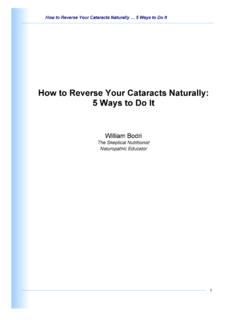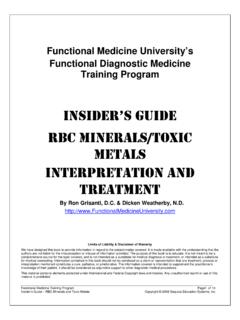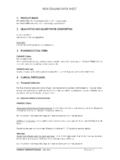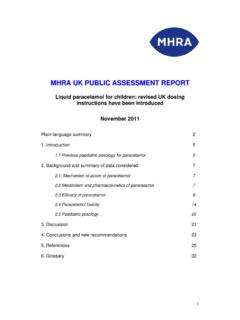Transcription of Biological Plausibility and Application to Risk …
1 Biological Plausibility and Application to Risk Assessment: Human Relevance and Dose Response Analysis Christopher J. Borgert, Biological Plausibility and Application to Risk Assessment: Human Relevance and Dose Response Analysis Christopher J. Borgert1,2, Patrick D. Guiney3, George Casella4, Kathleen T. Shiverick5. 1 Applied Pharmacology & Toxicology, Inc., Gainesville, FL. 2 Center for Environmental and Human Toxicology, Dept. of Physiological Sciences, University of Florida, Gainesville, FL. 3 Johnson & Son, Inc., Racine, WI. 4 Dept. of Statistics, University of Florida, Gainesville, FL. 5 Dept. of Pharmacology & Therapeutics, University of Florida, Gainesville, FL. 1. Section 0: OUTLINE. Outline Section 1: Philosophy Section 2: Practice Section 3: Pitfalls Section 4: Progress Section1:Philosophy What is Biological Plausibility ? Biological Plausibility means that the association is biologically believable. [testimony of eminent epidemiologist]. Consistent with Existing Knowledge. Biological Plausibility .
2 Depends upon existing knowledge about the mechanisms by which disease develops..[and] on the extent of scientific knowledge about the cellular and subcellular mechanisms through which the disease process works. (Reference Manual on Scientific Evidence - Epidemiology). 2. Section1:Philosophy How is Biological Plausibility Used? (f) Biological Plausibility . An inference of causality tends to be strengthened by consistency with data from experimental studies or other sources demonstrating plausible Biological mechanisms. A lack of mechanistic data, however, is not a reason to reject causality. [Cancer Assessment Guidelines Section , page 2-14]. Section1:Philosophy How is Biological Plausibility Evaluated? To evaluate whether an hypothesized mode of action is operative, an analysis starts with .. the hypothesized key events leading to cancer, and then weighing information to determine whether there is a causal relationship between these events and cancer formation, , that the effects are critical for induction of tumors.
3 It is not generally expected that the complete sequence will be known at the molecular level. Instead, empirical observations made at different levels of Biological organization biochemical, cellular, physiological, tissue, organ, and system are analyzed. [Cancer Assessment Guidelines Section , page 2-41.]. 3. Section1:Philosophy Causality: 1800's - 1900's Henle-Koch, 1882 Hill, 1965. [In Scheutz & Poulsen, 1999]. 1) Cause always present in 1) Strength disease 2) Consistency 2) Cause NOT in other 3) Specificity diseases 4) Temporality 3) Cause is isolable from 5) Biological Gradient diseased individual 6) Plausibility 4) Isolated cause 7) Coherence produces same disease 8) Experiment in other individuals 9) Analogy (animals). Section1:Philosophy Causal Propositions vs. Causal Assessments Hill, Susser, and others recognize that these criteria do not define cause per se, but merely provide guidelines for assessing it. Nonetheless, the criteria are occasionally used by epidemiologists and clinical researchers as though they provide an operational definition of causality.
4 Kramer & Lane, 1992. 4. Drawing by Dana Fradon: 1997 The New Yorker Magazine, Inc. Section1:Philosophy Cause Requires the Counterfactual .. an object followed by another ..where, if the first object had not been, the second never had existed.. David Hume, 1748. A key innovation of this definition was that it pivoted on a clause of the form if C had not occurred, D would not have either,' where C and D. are actually what occurred.. Maldonado & Greenland, 2002. 5. Section1:Philosophy Causal Chains Linear Causalism Attena, 1999. SmartDraw Electrical Circuit Diagram < > Section1:Philosophy 6. Section1:Philosophy Causal Mosaics Risk Factor Probabilism A. B. C D. A. C B. A C D. B. Scheutz & Poulsen, 1999. Section 2: Practice Omics Technologies Promises More sensitive biomarkers of exposure More precise biomarkers of effect Identify pre-toxicological changes Identify omic profiles associated with toxic responses Identify molecular mechanistic steps Elucidate complete toxicologic pathways Categorize chemicals by polyomic profiles Identify fundamentally similar modes of toxicity 7.
5 Section 2: Practice Promises of Omic Technologies Markers of Exposure Markers of Disease Exposure Prognostic Significance Internal Dose Clinical Disease Biologically Effective Dose Altered Structure/Function Early Biological Effect Markers of Susceptibility Section 2: Practice Replication DNA DNA. Transcription Pre-RNA. Post-Transcriptional Polyomics Modification RNA. Translation AA chain folding 1 Protein Post-Translational Modification Functional Protein Metabolites Biochemical / Cellular / Physiological / Tissues / Organs 8. Section 2: Practice Chinese Shoe Worker Cohort 250 workers from two shoe factories in China Broad range of benzene exposure Benzene levels analyzed over 16 months Co-exposure and sources investigated by principal component analysis and mixed effects models Range = ppm (highest in glue handlers). Vermeulen et al., 2004. Ann. Occup. Hyg. 48(2):105-116. Section 2: Practice Lan et al., 2005. Polymorphisms in cytokine and cellular adhesion molecule genes and susceptibility to hematotoxicity among workers exposed to benzene.
6 Cancer Res. 65(20): 9574-81. 9. Section 2: Practice Chinese Shoe Worker Cohort Proteomic Study Description Exposed: N=20 shoe workers - benzene levels monitored for 3 months prior to blood sample collection Control: N=20 clothing factory workers Blood serum proteins separated by pH, fractions applied to ProteinChip and analyzed by SELDI-TOF MS for mass/charge spectrum Created protein peak clusters and calculated p values for differences in peak intensity between exposed and control samples, those with p< were identified as potential biomarkers of interest (n=3). The three potential biomarkers were digested and analyzed by tandem MS for protein identification. Identification was confirmed by antibody ProteinChip analysis. Vermeulen et al. 2005. PNAS 102(47):17041-17046. Section 2: Practice Chinese Shoe Worker Cohort Proteomic Study Results Figure 5. Protein identification Figure 2. Confirmation of protein ID. Tandem MS Antibody ProteinChip SELDI-TOF MS. Figure 4. Differential protein expression - Physical property ProteinChip SELDI-TOF MS.
7 Vermeulen et al. 2005. PNAS 102(47):17041-17046. 10. Section 2: Practice Chinese Shoe Worker Cohort Metabolomic Study Description Exposed: N=250 shoe workers - benzene levels monitored by personal air samplers and urinary unmetabolized benzene Control: N=139 - benzene levels monitored by personal air samplers but measurements were below LOD so were estimated from urinary unmetabolized benzene Urine samples were analyzed by GC-MS for unmetabolized benzene and four benzene metabolites: E,E-muconic acid (MA), S-phenylmercapturic acid (SPMA), phenol (PH), catechol (CA), and hydroquinone (HQ). Median shoe worker benzene exposure = ( ppm). Median control benzene exposure (est.) = ( ppm). As exposure level increased, level of each metabolite also increased As exposure level increased, ratio of metabolite:benzene decreased (except SPMA) due to saturation of CYP metabolism Vermeulen et al. 2005. PNAS 102(47):17041-17046. Section 2: Practice Chinese Shoe Worker Cohort Metabolomic Study Results Kim et al.
8 2006. Carcinogenesis: Epub. 11. Section 3: Pitfalls Reliability: Molecular Correlations Directly addressed the question of whether the observed changes in mRNA expression were also reflected at the level of protein abundance. DNA microarrays, quantitative proteomics (using isotope- coded affinity tag (ICAT) reagents, and tandem mass spectrometry MS/MS) were used in an integrated approach to directly compare protein abundance with mRNA expression levels in Yeast. As a whole, protein-abundance ratios were moderately correlated with their mRNA counterparts (r = ). Underscores the importance of integrated mRNA- and protein- expression measurements. Ideker et al., 2001. Science 292(5518): 929. Section 3: Pitfalls Cytokine mRNA vs. Secreted Protein in RL 95-2 Human Uterine Endometrial Adenocarcinoma Cells Shiverick et al., unpublished data mRNA Secreted Protein Control: IL-1a = IL-1b>>IL-8 Control: only IL-8 detected BaP (10 uM)/TCDD (1 nM): BaP/TCDD: Increased IL-1a, IL-1B, IL-8 >>>> IL-8, slight > Il-1a Cytokine mRNA Expression Cytokine Secreted Protein Levels 250.
9 200. 150. pg/ml 100. 50. 0. IL-1a IL-1b IL-8. IL-1a IL-1b IL-8. DMSO BaP TCDD DMSO BaP TCDD. mRNA: Real-Time PCR using Taqman Protein in conditioned culture media: Cytokine Gene Expression Plate Quantikine ELISA Assay 12. Section 3: Pitfalls Genomics to Proteomics In similar fashion, protein levels per se may not be reflective of protein function or enzyme activity. Protein function and enzyme activity may depend on posttranslational modifications that are controlled by second messenger systems or other gene products not captured by an omic analysis of chemical effects. In order to probe how the polyomic level of Biological organization is involved in a specific mode of toxic action, it will be necessary to design experiments that probe whether gene expression results in expression of functional proteins that are appropriately targeted to the correct intra/extracellular compartments. Section 3: Pitfalls Griffin et al., 2002. Mol. Cell. Proteomics. 1:323-33. Using an integrated genomic and proteomic approach, we have investigated the effects of carbon source perturbation on steady-state gene expression in the yeast Saccharomyces cerevisiae growing on either galactose or ethanol.
10 For many genes, significant differences between the abundance ratio of the messenger RNA transcript and the corresponding protein product were observed. Insights into the perturbative effects on genes involved in respiration, energy generation, and protein synthesis were obtained that would not have been apparent from measurements made at either the messenger RNA or protein level alone, illustrating the power of integrating different types of data obtained from the same sample for the comprehensive characterization of Biological systems and processes. 13. Section 3: Pitfalls Griffin et al., 2002. Mol. Cell. Proteomics. 1:323-33. Section 3: Pitfalls Haugen et al., 2004. Integrating phenotypic and expression profiles to map arsenic-response networks. Genome Biol. 5:R95. The cellular effects of arsenic were profiled by gene expression and sensitivity phenotypes in S. cerevisiae, and mapped to a metabolic network composed of all known biochemical reactions in yeast, as well as the yeast network of 20,985 protein-protein/protein-DNA interactions.






